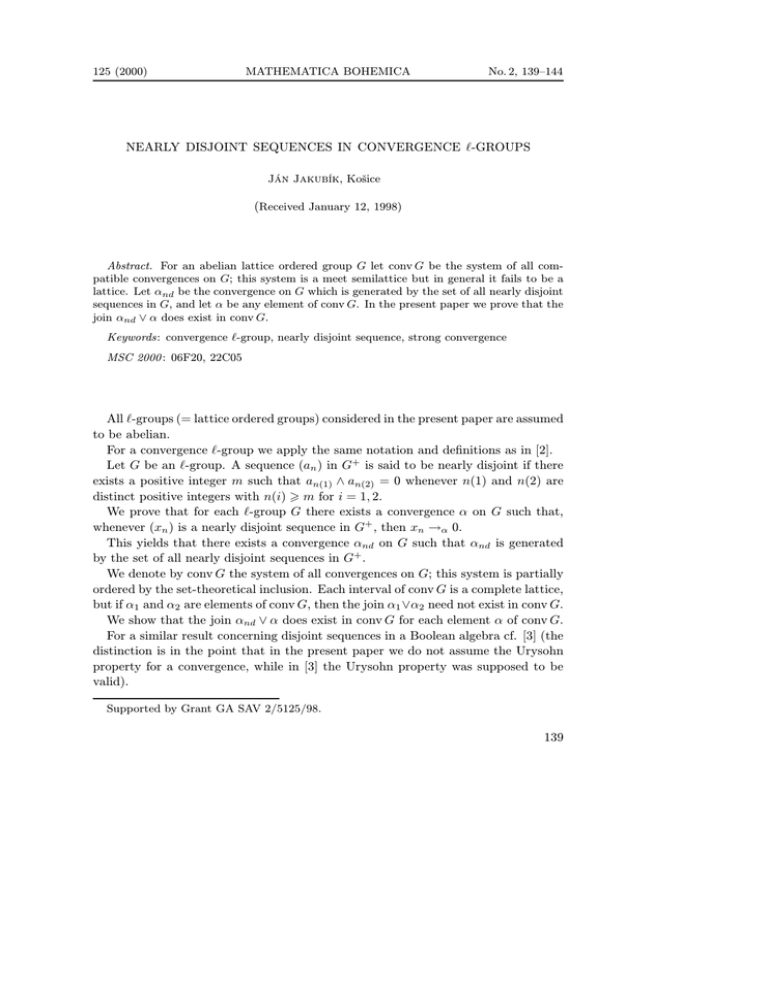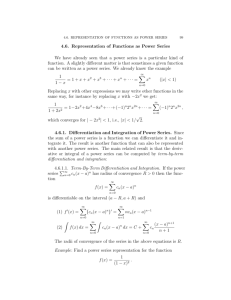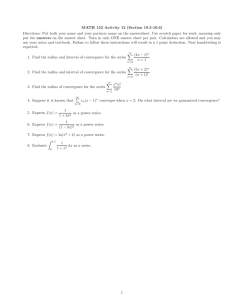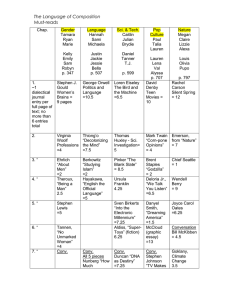(
advertisement

125 (2000)
MATHEMATICA BOHEMICA
No. 2, 139–144
NEARLY DISJOINT SEQUENCES IN CONVERGENCE -GROUPS
Ján Jakubík, Košice
(Received January 12, 1998)
Abstract. For an abelian lattice ordered group G let conv G be the system of all compatible convergences on G; this system is a meet semilattice but in general it fails to be a
lattice. Let αnd be the convergence on G which is generated by the set of all nearly disjoint
sequences in G, and let α be any element of conv G. In the present paper we prove that the
join αnd ∨ α does exist in conv G.
Keywords: convergence -group, nearly disjoint sequence, strong convergence
MSC 2000 : 06F20, 22C05
All -groups (= lattice ordered groups) considered in the present paper are assumed
to be abelian.
For a convergence -group we apply the same notation and definitions as in [2].
Let G be an -group. A sequence (an ) in G+ is said to be nearly disjoint if there
exists a positive integer m such that an(1) ∧ an(2) = 0 whenever n(1) and n(2) are
distinct positive integers with n(i) m for i = 1, 2.
We prove that for each -group G there exists a convergence α on G such that,
whenever (xn ) is a nearly disjoint sequence in G+ , then xn →α 0.
This yields that there exists a convergence αnd on G such that αnd is generated
by the set of all nearly disjoint sequences in G+ .
We denote by conv G the system of all convergences on G; this system is partially
ordered by the set-theoretical inclusion. Each interval of conv G is a complete lattice,
but if α1 and α2 are elements of conv G, then the join α1 ∨α2 need not exist in conv G.
We show that the join αnd ∨ α does exist in conv G for each element α of conv G.
For a similar result concerning disjoint sequences in a Boolean algebra cf. [3] (the
distinction is in the point that in the present paper we do not assume the Urysohn
property for a convergence, while in [3] the Urysohn property was supposed to be
valid).
Supported by Grant GA SAV 2/5125/98.
139
A convergence -group (G, α) will be called strong if for each g ∈ G with g > 0
there exists a sequence (xn ) in the interval [0, g] such that xn →α 0 and xn(1) = xn(2)
whenever n(1), n(2) are distinct positive integers. We use nearly disjoint sequences to
construct a proper class of nonisomorphic types of archimedean strong convergence
-groups.
1. Convergences generated by nearly disjoint sequences
In this section we assume that G is an -group. The symbol denotes the set of
all positive integers.
For the sake of completeness, we recall the following notation and definition concerning the notion of convergence in G as applied in [2].
Let g ∈ G and (gn ) ∈ G . If gn = g for each n ∈ , then we write (gn ) = const g.
such that hn = gn for each
For (hn ) ∈ G we put (hn ) ∼ (gn ) if there is m ∈
n ∈ with n m.
A convex subsemigroup α of the lattice ordered semigroup (G )+ = (G+ ) is said
to be a convergence on G if it satisfies the following conditions:
(I) If (gn ) ∈ α, then each subsequence of (gn ) belongs to α.
(II ) Let (gn ) ∈ α and (hn ) ∈ (G+ ) . If (hn ) ∼ (gn ), then (hn ) ∈ α.
(III) Let g ∈ G. Then const g ∈ α if and only if g = 0.
We denote by D(G) the system of all nearly disjoint sequences in G+ . Consider
the following condition for a sequence (an ) in G+ :
an = 0 is valid.
(∗) For each m ∈ , the relation
nm
1.1. Lemma. Let (bn ) be a sequence in G+ satisfying the condition (∗). Further,
let k ∈ and for each i ∈ {1, 2, . . . , k} let (xin ) be an element of D(G). Then the
sequence
(x1n + x2n + . . . + xkn + bn )
satisfies the condition (∗).
.
We put
un = x1n + x2n + . . . + xkn + bn
for each n ∈ . We proceed by induction with respect to k.
Let k = 1. By way of contradiction, suppose that (un ) does not satisfy the
condition (∗). Hence there are m ∈ and 0 < c ∈ G such that the relation
c x1n + bn
is valid for each n ∈
140
with n m.
We shall repeatedly use Riesz Decomposition Theorem. It yields that for each
n m there are c1n and c2n such that
c1n ∈ [0, x1n ],
c2n ∈ [0, bn ],
c = c1n + c2n .
If c1n = 0 for each n m, then c = c2n for each n m. This is impossible since
(bn ) satisfies the condition (∗).
Hence there is n(1) m such that c1n(1) > 0. Let n n(1) + 1. Then
c1n ∧ c1n(1) x1n ∧ x1n(1) = 0,
c1n(1) c,
thus c1n(1) c2n bn . We have arrived at a contradiction with the condition (∗) for
(bn ). Hence the assertion is valid for k = 1.
Let k > 1 and suppose that the assertion holds for k − 1. By way of contradiction,
suppose that it does not hold for k. Hence there exist m ∈ and 0 < c ∈ G such
that
c x1n + x2n + . . . + xkn + bn
is valid for each n m. Thus for each such n there are c1n , c2n and c3n in G such that
c = c1n + c2n + c3n ,
c1n ∈ [0, x1n + x2n + . . . + xnk−1 ],
c2n ∈ [0, xkn ],
c3n ∈ [0, bn ].
If c2n = 0 for each n m, then
c x1n + x2n + . . . + xnk−1 + bn
for each n m, which is a contradiction with the induction assumption.
Thus there exists n(1) m with c2n(1) > 0. Put m1 = n(1) + 1 and let n m1 .
Then
c2n(1) c, c2n(1) ∧ c2n akn(1) ∧ akn = 0,
whence c2n(1) c1n + c3n . Therefore
c2n(1) x1n + x2n + . . . + xnk−1 + bn
for each n m1 . This is again a contradiction with the induction assumption.
1.2. Corollary. Let k ∈ and for each i ∈ {1, 2, . . . , k} let (xin ) be an element
of D(G). Then the sequence (x1n + x2n + . . . + xkn ) satisfies the condition (∗).
A nonempty subset X of (G+ ) is said to be regular if there exists α ∈ conv G
such that X ⊆ α.
141
1.3. Lemma. Let X be a nonempty subset of (G+ ) . Then the following
conditions are equivalent:
(i) X is regular.
(ii) Whenever 0 c ∈ G, (x1n ), (x2n ), . . . , (xkn ) ∈ X, (yni ) is a subsequence of (xin )
for i = 1, 2, . . . , k, and K, m ∈ satisfy
c K(yn1 + yn2 + . . . + ynk )
for each n ∈
.
with n m, then c = 0.
This is a consequence of Proposition 2.3 in [2].
1.4. Lemma. The set D(G) is regular.
.
Let (x1n ), (x2n ), . . . , (xkn ) be elements of D(G). For each i ∈ {1, 2, . . . , k}
let
be a subsequence of (xin ). If K ∈ , then (Kyni ) belongs to D(G) for
i = 1, 2, . . . , k. Now it suffices to apply 1.2 and 1.3.
(yni )
Let ∅ = X ⊆ (G+ ) and α ∈ conv G. Suppose that
(i) X ⊆ α;
(ii) whenever β ∈ conv G and X ⊆ β, then α ⊆ β.
Under these conditions the convergence α is said to be generated by the set X.
We denote by D1 (G) the set of all sequences (un ) which satisfy the following
condition: there exist (x1n ), (x2n ), . . . , (xkn ) in D(G) such that
un = x1n + x2n + . . . + xkn
for each n ∈ .
From Proposition 2.3 in [2] we obtain
1.5. Lemma. Let X be a regular subset of (G+ ) and let (zn ) be a sequence in
G+ . Then the following conditions are equivalent:
(i) (zn ) belongs to the convergence on G which is generated by X.
(ii) There exist (x1n ), (x2n ), . . . , (xkn ) ∈ X, K ∈ M , m ∈ and (yn1 ), (yn2 ), . . . , (ynk ) ∈
(G+ ) such that (yni ) is a subsequence of (xin ) (i = 1, 2, . . . , k) and
zn K(yn1 + yn2 + . . . + ynk )
is valid for each n ∈
with n m.
Let the meaning of αnd be as in the introduction; in view of 1.4, αnd does exist.
1.6. Proposition. D1 (G) = αnd .
142
. It is clear that D(G) ⊆ αnd and hence D1 (G) ⊆ αnd . Let (zn ) ∈ αnd .
We apply 1.5 for X = D(G). Then (under the notation as in 1.5) (Kyni ) ∈ D(G) for
i = 1, 2, . . . , k, and for each n m the element zn can be written in the form
zn = t1n + t2n + . . . + tkn
with tin ∈ [0, Kyni ], i = 1, 2, . . . , k. Thus (tin ) ∈ D(G) for i = 1, 2, . . . , k and hence
(zn ) ∈ D1 (G).
1.7. Lemma. Let α ∈ conv G, X = α ∪ αnd . Then X is regular.
.
This is a consequence of 1.1 and 1.6.
From 1.7 and from Proposition 2.1 in [2] we obtain
1.8. Theorem. Let α ∈ conv G. Then the join α ∨ αnd does exist in conv G.
2. Strong convergence -groups
We apply the notion of strong convergence -group as defined in the introduction.
. Let be the set of all reals with the usual topology and let
2.1
H be the additive group of all continuous real functions on . The set H is partially
ordered coordinate-wise. Then H is an archimedean -group. Put α = D1 (H). In
view of 1.6, (H, α) is a convergence -group. Let 0 < f ∈ H. There exist fn ∈ [0, f ]
(n ∈ ) such that fn > 0 for each n ∈ and fn(1) ∧ fn(2) = 0 whenever n(1) and
n(2) are distinct positive integers. Thus fn →α 0. Therefore the convergence -group
(H, α) is strong.
2.2.
.
H is as in 2.1. Put
Let I be a nonempty set and for each i ∈ I let Hi = H, where
H(I) =
Hi .
i∈I
Then H is an archimedean -group.
For i ∈ I and f ∈ H(I) let f i be the component of f in Hi . Let 0 < f ∈
H(I). Thus there is i ∈ I such that f i > 0. Then in view of the properties of
H (cf. 2.1) there exist fn ∈ [0, f ] (n ∈ ) such that fn > 0 for each n ∈
and
fn(1) ∧ fn(2) = 0 whenever n(1), n(2) are distinct positive integers. Thus fn →α 0,
where α = D1 (H(I)). Hence (H(I), α) is a strong convergence -group.
Let I1 and I2 be nonempty sets such that
(1)
card I1 = card I2 .
143
It is easy to verify that the -group H is directly indecomposable. If an -group has
a direct product decomposition with nonzero directly indecomposable direct factors,
then this direct decomposition is uniquely determined (this is a consequence of the
well-known Shimbireva’s theorem [4] on the existence of a common refinement of any
two direct product decompositions of a directed group; cf. also Fuchs [1]). Hence
the number of nonzero directly indecomposable direct factors of H(Ik ) is equal to
card Ik (k = 1, 2). This yields that whenever (1) holds, then H((I1 ) and (H(I2 )
are not isomorphic. Therefore the convergence -groups (H(I1 ), D1 (H(I1 ))) and
(H(I2 ), D1 (H(I2 ))) are not isomorphic.
From this we conclude
2.3. Proposition. There exists a proper class of nonisomorphic types of archimedean strong convergence -groups.
Let us denote by S the class of all -groups G having the property that there is
α ∈ conv G such that (G, α) is a strong convergence -group.
It is easy to verify that the class S is closed with respect to -subgroups and with
respect to direct products. The following example shows that S is not closed with
respect to homomorphisms. Hence S fails to be a variety.
2.4.
.
Let and be the additive group of all integers or of all
reals, respectively, with the natural linear order. Put
G = ◦ ,
where the symbol ◦ denotes the lexicographic product. Then G ∈ S, but the factor
-group G/ (being isomorphic to ) does not belong to S.
We remark without proof that S is a radical class of -groups.
References
[1] L. Fuchs: Partially Ordered Algebraic Systems. Pergamon Press, Oxford, 1963.
[2] J. Jakubík: Sequential convergences in -groups without Urysohn’s axiom. Czechoslovak
Math. J. 42 (1992), 101–116.
[3] J. Jakubík: Disjoint sequences in Boolean algebras. Math. Bohem 123 (1998), 411–418.
[4] E. P. Shimbireva: On the theory of partially ordered groups. Matem. Sbornik 20 (1947),
145–178. (In Russian.)
Author’s address: Ján Jakubík, Matematický ústav SAV, Grešákova 6, 040 01 Košice,
Slovakia, e-mail: musavke@linux1.saske.sk.
144




